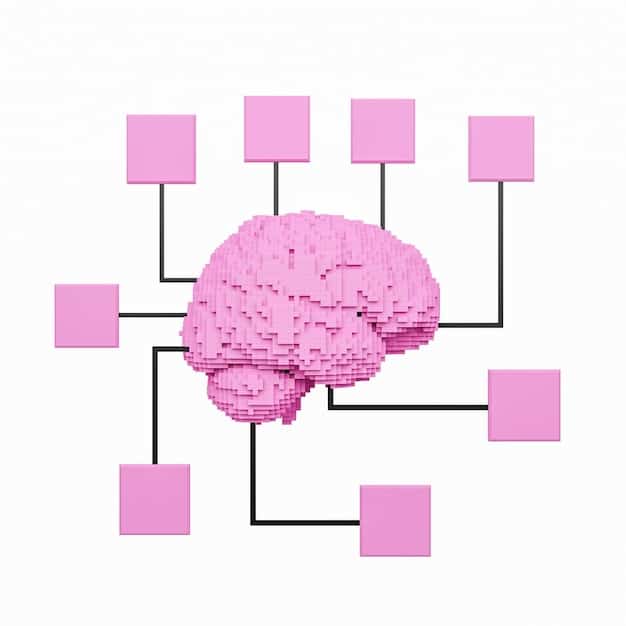Boost Learning Efficiency: Dual Coding with Visuals and Text

Dual coding enhances learning by integrating verbal and visual information, capitalizing on the brain’s natural ability to process both, which can lead to a significant increase, potentially up to a 40%, in learning efficiency and information retention.
Unlock a powerful learning technique that leverages how your brain naturally processes information. Dual coding combines the strengths of visual and textual information, leading to a potential 40% boost in learning efficiency. Let’s explore how you can use this to supercharge your study sessions.
What is Dual Coding and Why Does It Work?
Dual coding theory, developed by Allan Paivio, suggests that we process information in two distinct but interconnected systems: verbal and non-verbal (imagery). Understanding this can transform how you approach learning.
The Core Principles of Dual Coding
At its heart, dual coding theory proposes that our brains are wired to handle both words and images, and when we combine these two, we create richer, more memorable learning experiences.
How It Enhances Memory
By engaging both systems, verbal and visual, we create multiple pathways for retrieving information. This redundancy makes it easier to recall what we’ve learned, even under pressure.

Consider how you remember a story better when you can visualize the scenes. That’s dual coding in action.
- Creates multiple mental pathways.
- Engages both verbal and visual memory.
- Enhances recall and retention.
Dual coding isn’t just a theory; it’s a practical approach to optimize your learning process for better results. It encourages active engagement and deeper understanding.
Applying Dual Coding in Your Study Routine
Incorporating dual coding into your study routine is surprisingly straightforward. It begins with consciously linking text with corresponding visuals to create a stronger neural connection.
Transforming Text into Visuals
Start by identifying key concepts in your notes or textbooks and then try to represent those concepts visually. Think diagrams, charts, mind maps, or even simple drawings.
Using Visuals to Reinforce Text
When reviewing your notes, actively recall the images you associated with the text. This mental exercise strengthens the connections between the verbal and non-verbal systems.
Imagine you’re studying history. Instead of just reading about a historical event, draw a simple timeline or a map illustrating the key locations. That visual anchor will significantly improve your recall.
- Create diagrams and charts.
- Draw mind maps to connect ideas.
- Use simple sketches to illustrate concepts.
By actively converting information into visual forms, you’re essentially creating your own personalized mnemonic devices, making information more accessible and easier to remember.
Effective Visual Aids for Dual Coding
The effectiveness of dual coding hinges on the quality of your visual aids. They should be clear, relevant, and engaging to maximize the benefits of this learning technique.
Mind Maps and Concept Maps
Mind maps are great for visually organizing information around a central concept, while concept maps illustrate relationships between different ideas. Both are ideal for complex topics.
Diagrams and Flowcharts
Diagrams can simplify complex processes or systems, while flowcharts are perfect for visualizing sequences or steps in a process.

Illustrations and Sketches
Even simple drawings can be powerful tools for illustrating key concepts or visualizing abstract ideas. Don’t worry about your artistic skills; clarity is more important than aesthetics.
Ensure your visuals are well-labeled and directly relevant to the text you’re studying. The goal is to create a seamless connection between the words and images.
- Use color to highlight key points.
- Keep visuals simple and uncluttered.
- Label diagrams and charts clearly.
The right visual aids transform abstract information into concrete, memorable images, boosting your comprehension and retention levels significantly.
Tools and Resources for Dual Coding
Fortunately, many tools and resources can help you effectively implement dual coding in your study strategies. These tools range from simple paper and pen to sophisticated software.
Digital Mind Mapping Software
Software like MindMeister, XMind, and Coggle are excellent for creating digital mind maps and concept maps. They offer features such as cloud storage, collaboration, and customizable templates.
Note-Taking Apps with Visual Integration
Apps like Evernote, OneNote, and Notion allow you to embed images, sketches, and diagrams directly into your notes, making it easy to create visually rich study materials.
Online Diagramming Tools
Websites like Lucidchart and Draw.io provide a wide range of templates and tools for creating diagrams, flowcharts, and other visual aids.
Embrace these resources to make dual coding an easy and effective part of your study routine. The digital age offers unparalleled opportunities to enhance your learning through visual integration.
- Explore mind mapping software.
- Use note-taking apps with image support.
- Try online diagramming tools.
By leveraging these resources, you can transform your study sessions into engaging, effective learning experiences that harness the power of dual coding.
Overcoming Challenges in Dual Coding
While dual coding is incredibly powerful, it’s not without its challenges. Recognizing these potential pitfalls and learning how to overcome them is key to maximizing its benefits.
Avoiding Information Overload
One common mistake is trying to visualize every single detail, which can lead to information overload. Focus on representing the most important concepts and connections.
Ensuring Visuals Are Relevant
Visuals should directly relate to the text; otherwise, they can be a distraction. Make sure each image reinforces the concept it’s meant to illustrate.
Time Management
Creating effective visuals can take time, so it’s important to balance the benefits of dual coding with efficient time management. Prioritize the most challenging or important topics for visual representation.
Be mindful of these challenges and actively work to mitigate them. By focusing on clarity, relevance, and prioritization, you can harness the full potential of dual coding without getting bogged down.
- Focus on key concepts.
- Ensure visuals are relevant.
- Manage your time effectively.
By acknowledging and addressing these challenges, you can refine your approach to dual coding and create a more effective and sustainable learning strategy.
The Science Behind Dual Coding: Research and Studies
The effectiveness of dual coding is supported by a wealth of research in cognitive psychology and education. Understanding the science behind it can further motivate you to incorporate it into your learning strategies.
Paivio’s Pioneering Work
Allan Paivio’s original research laid the foundation for dual coding theory, demonstrating that memory is significantly enhanced when information is presented in both verbal and visual forms.
Studies on Multimedia Learning
Research in multimedia learning, led by Richard Mayer, has consistently shown that students learn better when words and pictures are combined effectively, aligning with the principles of dual coding.
Neuroimaging Evidence
Neuroimaging studies have provided insights into how the brain processes verbal and visual information separately and in conjunction, confirming that dual coding activates multiple brain regions, leading to better memory consolidation.
Delving into these studies can provide a deeper appreciation for the science-backed effectiveness of dual coding, convincing you to integrate it into your study habits. Understanding how it works on a neurological level can be highly motivating.
- Explore Paivio’s original research.
- Review studies on multimedia learning.
- Look into neuroimaging evidence.
The evidence is clear: dual coding is not just a trendy learning technique; it’s a powerful, research-backed strategy that can significantly improve your learning outcomes.
| Key Point | Brief Description |
|---|---|
| 🧠 Verbal & Visual | Combines text and images for better learning. |
| 🖼️ Mind Maps | Organize information visually around a central idea. |
| 📈 Boost | Enhances memory, recall, and understanding. |
| 🛠️ Tools | Use software to easily create visual aids. |
Frequently Asked Questions About Dual Coding
▼
Dual coding theory is a cognitive theory that proposes we process information through two separate channels: verbal and non-verbal (imagery). Using both channels can enhance memory and learning. It emphasizes the importance of combining words and visuals for better understanding.
▼
By creating stronger and more varied memory traces, dual coding helps in recalling information during exams. Visual cues act as triggers, prompting recall more effectively than just rote memorization of text. This leads to a deeper grasp of concepts.
▼
While dual coding is beneficial across subjects, it’s particularly useful for visual subjects like geography, biology, and history. However, even in abstract fields like mathematics, diagrams and visual representations can greatly aid in comprehension.
▼
Dual coding can benefit most learners, but it particularly helps visual learners. However, it can also enhance learning for auditory and kinesthetic learners by providing a more engaging and multi-sensory learning experience, improving retention overall.
▼
Yes, dual coding is an excellent group study tool. Collaboratively creating mind maps, diagrams, or even acting out scenarios can enhance understanding and memory for all participants, making study sessions more interactive and effective. It also encourages diverse interpretations.
Conclusion
Integrating dual coding into your study routine can transform how you learn, enhancing memory retention and comprehension. By actively connecting text with visuals, you create stronger neural pathways that make learning more efficient and enjoyable. So, start experimenting with mind maps, diagrams, and sketches, and unlock your full learning potential.





